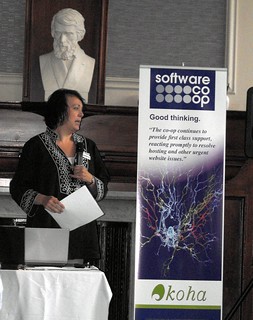Koha ILS
KohaCon12: Top Ten Data Migration Strategies
Our very own Joy Nelson was up this morning. She started mentioning that migration is not as easy as moving information from point A to B. It’s about getting things to fit in the right spot and at the end of the day it’s not the data that tells you you’re done, it’s the people.
You have to keep a good relationship with your client:
- Manage expectations
- Communicate
- We provide a communication plan with our partners before we get started so that they know how to communicate with us, when we’ll be contacting them.
- Maintain a schedule
- Stay on topic!! Meetings that spiral off the agenda are hard to document, hard to follow up on and hard to keep track of
- Clarify language. We all use different words for the same things. So make sure you’re all on the same page.
- Watch your jargon. Not everyone understands the technical language we use. The same goes for the client. Have them clarify words that you maybe don’t know
- Mind the body language. Don’t roll your eyes or scowl, be professional.
- Listen
- Empathize
Documentation is also central to a good migration! Make sure you document from the second they sign to the point that they go live. You want to know where they’re coming from and what order we’re going to do things in. Also a knowledge base can be very helpful – this is a great place to store all the manuals for the ILSes people are migrating from or canned scripts you have to clean up data from a specific system.
Become familiar with your client’s workflows and try to explain things using that workflow. This makes them more comfortable and makes it easier to communicate.
The next tip … be consistent!
Keep the process consistent regardless of which library you’re working with or which ILS they’re coming from. This makes it easier to jump from one migration to another and work on multiple processes at once because you know the process. Another level of consistency is to have consistent tools and methods. Finally, all programmers know this on, keep consistent naming conventions.
Next up the aesthetics. The appearance of the OPAC matters and working on that during the migration makes people happy.
Be flexible! Meet your libraries where they are in terms of technical skills. Be flexible to take the extra effort to maybe walk the through creating a CSV file for their data or running a specific report to get the data out of their old system. Sometimes finding tools to assist them will make it easier for everyone involved.
Anticipation – knowing what’s coming down the road will help with your migration. When the library says they need something it’s handy to know if it’s coming down the pike in Koha. We know what’s coming and it makes them feel better to know that it’s around the bend. You also need to give them the information to understand their decisions, they need to know that choosing this preference will effect the workflow in a specific way.
Finally – Transparency of Process is key. Make it clear that their data is theirs and you’re just there to get it in to the system the way they want. Let them know what you’re doing along the way. Engage them in the process so that they get a feel for what it’s like to be part of an open source community.
[tags]kohacon12[/tags]
Read more by Nicole C.

